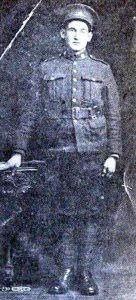Tom Slater & Tom St. Amand
As fiery explosions blanketed the battlefield below a Canadian pilot wondered: “How anything or anyone could have survived it, I do not know.”
The date was Sept. 27, 1918 and the pilot was witnessing the first day of the Battle of Canal du Nord and Cambrai, the third stage of Canada's Hundred Days Offensive and the final chapter of the First World War.
It was the war’s heaviest single day bombardment and when the fighting ended with an Allied victory on Oct. 11, nine Sarnians were among the thousands killed.
Following victories at Amiens and Arras, the Allies were eager to end the four-year-old conflict. In their way stood two major impediments in France: The Canal du Nord, part of the main Hindenburg Line, the last trench system of German defence; and Cambrai, a vital logistical hub and railway centre, the key to the Hindenburg defences.
The Canadian Corps was again ordered to spearhead the attack. Once the Canadians channeled through a narrow gap of the treacherous Canal du Nord, they would have to overcome the Germans at Bourlon Wood, a heavily fortified and forested hill overlooking the canal. Next they would have to move east through the formidable Marcoing Line, numerous enemy-

occupied villages, and interlocking trenches before attempting to take Cambrai.
A fortnight later, the Allies prevailed despite being heavily outnumbered.
The Canadians were courageous and relentless as they led the way and cemented their reputation as an elite fighting force, forged with the blood of thousands of fallen countrymen. Three Sarnians were killed in action on Sept. 27th.
Private Albert Pringle of the 47th Battalion, a 37-year-old father of six died instantly from enemy shell fire.
Private John Salisbury, 21, of the 15th Battalion, was acting as a stretcher-bearer when he was shot fatally in the head.
After leaving his Brock Street home to enlist two years earlier, Private Frederick Robinson, 19, was killed in action near Haynecourt.
On Sept. 29th, Private Joseph Carson, 26, a former Imperial Oil employee, was hit in the stomach by enemy machine gun fire and killed instantly. As one historian noted, “the German machine-gunners proved to be the Canadians' nemesis through the last half of the 100 days.”
On Oct. 1, three more Sarnians fell. Private George Beaumont, 23, of the 43rd Battalion was strafed with enemy machine gun fire in a counter attack near Tilloy. An officer informed his parents back home their brave son “was killed instantly, thereby suffering no pain.”
Lieutenant Roy Crawford, 21, died the same way near Blecourt. His mother, just a few days before at her Russell Street home, had displayed the Military Medal for Bravery her son had earned at Passchendaele. She proudly told visitors that Roy Crawford had brought honour on her home. She learned of his death two weeks later.
A stained glass window, erected in 1928 to commemorate Edward Watson, can still be seen in Lighthouse Community Church, formerly Parker Street United Church. Private Watson, 23, was killed in action with the 1st Battalion.
Two days later, Private Alex Cunningham, 24, with the 43rd Battalion, died from shrapnel wounds to his right arm and head.
On Oct. 11, Private Sid Davies, 36, of the 18th Battalion, was killed when an enemy shell exploded near him. It was the last day of the battle, exactly one month before the end of the war.
Canal du Nord and Cambrai remain one of the costliest battles in Sarnia's military history.
The names of all nine men are engraved on the cenotaph at Veterans Park.
